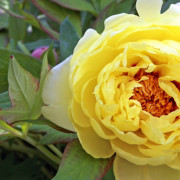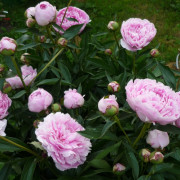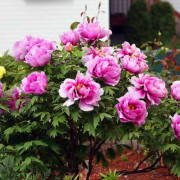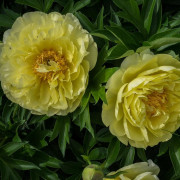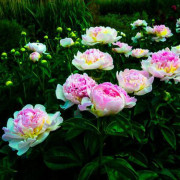Peony Buckeye Bell (Paeonia Buckeye Belle) - features of cultivation
Content:
Peonies are rightfully considered one of the best and most popular perennial flower varieties. In total, there are 34 species and about 5000 varieties of peonies. One of the brightest representatives of this genus is the Buckeye Belle peony. Its bright large flowers look good both in the garden and in bouquets. Those who want to plant it on their own plot and enjoy the beauty of flowering need to know the peculiarities of cultivation and care.
Peony Buckeye Bell (Paeonia Buckeye Belle) - what is this variety
The peony variety Bakai Bella was bred in 1956. It is characterized by semi-double flowers of a rich red hue. One flower reaches 15-16 cm in diameter.
Peony Buckeye Bell - variety description
Shiny round petals are arranged in several rows. Bright yellow stamens grow in the center of the flower. Powerful upright stems reach 80-90 cm in height. The bush is compact in size and has a well-developed root system.
Advantages and disadvantages of the variety
The selection of Buckeye Bell peonies is based on an assessment of the benefits:
- large semi-double flowers are painted in bright colors;
- unsurpassed aroma spreading throughout the garden;
- attractive appearance and long-term storage after cutting;
- unpretentious care, allowing even beginners to grow peonies;
- optional pesticide treatment;
- good immunity to many diseases;
- decorative appearance even after cutting the flowers.
Among the disadvantages can be noted susceptibility to aphids and other pests.
Use in landscape design
The compact size of the bush and luxurious large flowers make it possible to grow this variety both alone and in group plantings.
In landscaping, it goes well with the following plants:
- honeysuckle;
- daisies;
- juniper;
- tulips;
- chrysanthemums;
- astilba;
- poppy and others.
Often, designers add this flower when creating rock gardens, mixborders and rabatki. Bakai Bel peonies, like milky-flowered peonies, look good by the pond, gazebos and near the house.
Growing a flower, how to plant it in open ground
Reproduction of peonies occurs most often by dividing the bush. This procedure can be done with 3-6 year old plants. For regions located in northern latitudes, the optimal time for landing is late August - mid September.
To obtain planting material, the root system of an adult bush is carefully dug out. The roots of the plant are fragile and go deep into the ground, so there is no need to rush. It is best to use a garden pitchfork to extract the rhizome.
The extracted part of the peony is cleaned from the ground, washed out with warm water and placed in the shade for several hours to dry. The greens are trimmed, leaving about 10 cm from the stem.
Location selection
Before planting a Bucky Belle peony, you need to choose the optimal location for it. Plants prefer open, well-lit areas without drafts.
Soil preparation
The soil should be prepared 3-4 weeks before planting. To do this, a shallow hole is dug in the selected place and 2/3 filled with a mixture of the following components:
- river sand;
- peat;
- humus;
- land;
- 250 g double superphosphate;
- 1 tbsp. l. iron sulfate.
The planting material itself is placed in a weak solution of potassium permanganate for 2-3 hours in order to protect the future plant from fungal diseases. Existing cuts are treated with crushed coal.
Planting procedure step by step
Planting seedlings or peony cuttings occurs using the following technology:
- Dig a hole about 50-60 cm deep and the same diameter.
- Drainage with any small stones.
- 2/3 fall asleep with the prepared mixture.
- The peony is planted to such a depth that the buds protrude from the surface by 3-4 cm.
- The root system is covered with earth and mulching with peat is performed on top.
- The final stage is abundant watering.
Seed planting
This type of propagation of peonies is used only by experienced growers and breeders, since it is a long and painstaking process.
- The seeds are harvested from mid-August to mid-September.
- Sowing is carried out to a depth of about 5 cm. This procedure will speed up the germination process so that sprouts appear from the seeds by the next season.
- If the planting material went through a warm and cold period, but did not germinate in the first year, it is possible that sprouts will appear in a year.
Plant care
Peony Buckeye Bell is not particularly demanding in care. He needs standard activities that are suitable for many varieties.
Watering and feeding
For young plants, it is better to choose foliar feeding. From the second half of May, every 3-4 weeks, plant leaves are irrigated with a solution of complex mineral fertilizer. For better wetting of the greens, you can add 1 tbsp to the finished solution. l. soap or powder.
It is recommended for adult peony bushes to carry out three stages of foliar dressing:
- In the period May 7-15, plants are fertilized with a urea solution. To prepare it for 10 liters of water, 50 g of the main component is required.
- 3 weeks after the first fertilization, a urea solution is also applied, to which 1 tablet of micronutrient fertilizers is previously added.
- 3 weeks after the second stage, 2 micronutrient tablets are added to a similar solution.
Watering is an equally important procedure. It is especially needed in early spring during bud formation and at the end of summer. For one bush, 2-3 buckets of settled water are spent.
Mulching and loosening
Loosening is carried out after each watering. The procedure allows you to remove weeds and improve soil air exchange. It is possible to reduce its frequency and retain moisture in the upper soil layer using mulching. It involves the organization of a 5-7 cm layer of needles, straw or peat, laid out around the bush.
Preventive treatment
Preventive measures are aimed at preventing the development of diseases that are characteristic of this variety. The first treatment involves watering the soil with a weak solution of potassium permanganate. Its task is to prevent the development of fungal and viral diseases. The second is carried out in 7-10 days.It involves spraying the plant with Bordeaux mixture in order to prevent the development of gray rot.
Peony Blossom Bucky Belle
Peony blooms in May-June, depending on the characteristics of the climatic zone in which it grows. The flowering period itself lasts from 1.5 to 3 weeks. But thanks to its delicate leaves, it remains decorative all season.
For regular and long-term flowering, certain care rules must be observed:
- choose lighted areas with partial shade for planting;
- plant a young plant correctly, leaving all the buds above the ground;
- carry out abundant watering and mulch the soil;
- plant Bikey Belli peony on fertile soils and carry out regular feeding;
- properly prepare the plant for winter.
After the peonies have bloomed, it is recommended to cut off all flowers. And after 2-2.5 weeks, fertilize the bushes with potash and phosphorus compounds. Watering is maintained throughout the summer, and becomes more abundant in August.
What to do if the peony does not bloom
A peony may not bloom for several reasons:
- Improper landing, in which the buds are located in the ground or, conversely, high above its surface.
- Too large cuttings, the roots of which cannot provide the plant with the necessary amount of nutrients.
- Lack of watering and fertilization last summer.
- Planting a peony in a dark place.
- Large age of the bush. Such a plant involves digging with subsequent division.
- Soil with high acidity. To normalize this indicator, it is recommended to add wood ash or lime to the ground.
- In the spring frost, the kidneys froze. To eliminate the cause, the correct organization of the winter cover is recommended.
- Early leaf pruning that was done last season.
- Excessive amount of nitrogen fertilizers, which only contribute to the growth of greenery.
Peonies after flowering
On average, peonies can grow in one place for no more than 10 years, after which they will need to be transplanted and divided. The best option is to transplant them every 5 years. The flower has a highly developed root system, which makes it much easier to transplant a young bush.
The rest of the bushes are pruned at this time. The stems are cut below the surface of the ground and burned. Part of the cut is sprinkled with wood ash. Young shrubs are covered with a thick layer of mulch; no cover for mature plants is required.
In addition to pruning and covering peonies, it is recommended to water them abundantly before the onset of frost.
Diseases and pests
This variety is susceptible to diseases caused by viruses and fungi. Namely:
- gray rot;
- rust;
- mosaic disease;
- septoria and others.
Often on the leaves you can find:
- ants;
- aphids;
- nematodes;
- thrips.
In the initial stages of the disease, the removal of the affected parts and the mechanical collection of insects will help. In case of more severe damage, it is recommended to use insecticides and fungicides, such as:
- Tsineb;
- Ultor;
- Topaz;
- Tanrek;
- Thunderstorm
- Bordeaux liquid and others.
The peony variety Buckeye Bell is distinguished by spectacular large flowers that will adorn any garden and bouquet. Unpretentious care, decorative properties and a long flowering period make the variety popular among gardeners. In addition, it is believed that a peony planted in the garden promises wealth.















